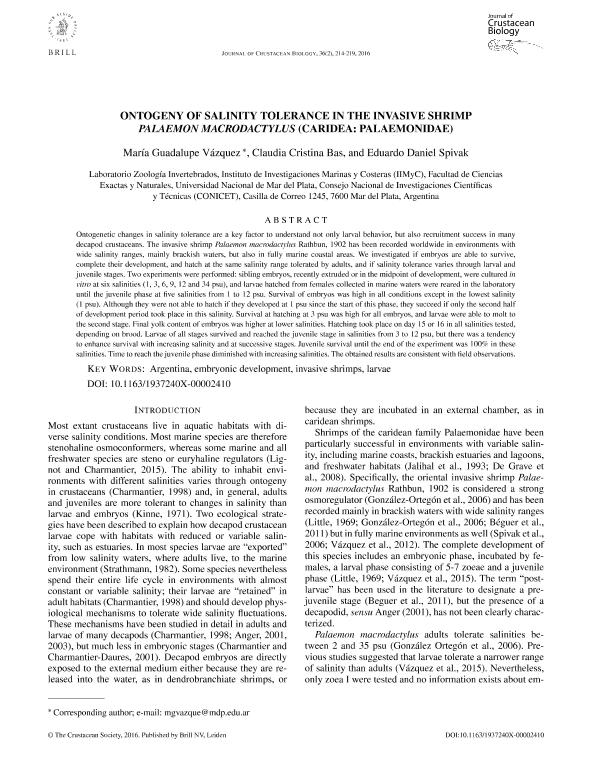Mostrar el registro sencillo del ítem
dc.contributor.author
Vázquez, María Guadalupe

dc.contributor.author
Bas, Claudia Cristina

dc.contributor.author
Spivak, Eduardo Daniel

dc.date.available
2018-08-13T19:27:20Z
dc.date.issued
2015-12
dc.identifier.citation
Vázquez, María Guadalupe; Bas, Claudia Cristina; Spivak, Eduardo Daniel; Ontogeny of salinity tolerance in the invasive shrimp Palaemon macrodactylus (Caridea: Palaemonidae); Crustacean Society; Journal of Crustacean Biology; 36; 2; 12-2015; 214-219
dc.identifier.issn
0278-0372
dc.identifier.uri
http://hdl.handle.net/11336/55205
dc.description.abstract
Ontogenetic changes in salinity tolerance are a key factor to understand not only larval behavior, but also recruitment success in many decapod crustaceans. The invasive shrimp Palaemon macrodactylus Rathbun, 1902 has been recorded worldwide in environments with wide salinity ranges, mainly brackish waters, but also in fully marine coastal areas. We investigated if embryos are able to survive, complete their development, and hatch at the same salinity range tolerated by adults, and if salinity tolerance varies through larval and juvenile stages. Two experiments were performed: sibling embryos, recently extruded or in the midpoint of development, were cultured in vitro at six salinities (1, 3, 6, 9, 12 and 34 psu), and larvae hatched from females collected in marine waters were reared in the laboratory until the juvenile phase at five salinities from 1 to 12 psu. Survival of embryos was high in all conditions except in the lowest salinity (1 psu). Although they were not able to hatch if they developed at 1 psu since the start of this phase, they succeed if only the second half of development period took place in this salinity. Survival at hatching at 3 psu was high for all embryos, and larvae were able to molt to the second stage. Final yolk content of embryos was higher at lower salinities. Hatching took place on day 15 or 16 in all salinities tested, depending on brood. Larvae of all stages survived and reached the juvenile stage in salinities from 3 to 12 psu, but there was a tendency to enhance survival with increasing salinity and at successive stages. Juvenile survival until the end of the experiment was 100% in these salinities. Time to reach the juvenile phase diminished with increasing salinities. The obtained results are consistent with field observations.
dc.format
application/pdf
dc.language.iso
eng
dc.publisher
Crustacean Society

dc.rights
info:eu-repo/semantics/openAccess
dc.rights.uri
https://creativecommons.org/licenses/by-nc-sa/2.5/ar/
dc.subject
Argentina
dc.subject
Embryonic Development
dc.subject
Invasive Shrimps
dc.subject
Larvae
dc.subject.classification
Otras Ciencias Biológicas

dc.subject.classification
Ciencias Biológicas

dc.subject.classification
CIENCIAS NATURALES Y EXACTAS

dc.title
Ontogeny of salinity tolerance in the invasive shrimp Palaemon macrodactylus (Caridea: Palaemonidae)
dc.type
info:eu-repo/semantics/article
dc.type
info:ar-repo/semantics/artículo
dc.type
info:eu-repo/semantics/publishedVersion
dc.date.updated
2018-06-29T13:11:18Z
dc.journal.volume
36
dc.journal.number
2
dc.journal.pagination
214-219
dc.journal.pais
Estados Unidos

dc.journal.ciudad
Lawrence
dc.description.fil
Fil: Vázquez, María Guadalupe. Consejo Nacional de Investigaciones Científicas y Técnicas. Centro Científico Tecnológico Conicet - Mar del Plata. Instituto de Investigaciones Marinas y Costeras. Universidad Nacional de Mar del Plata. Facultad de Ciencia Exactas y Naturales. Instituto de Investigaciones Marinas y Costeras; Argentina
dc.description.fil
Fil: Bas, Claudia Cristina. Consejo Nacional de Investigaciones Científicas y Técnicas. Centro Científico Tecnológico Conicet - Mar del Plata. Instituto de Investigaciones Marinas y Costeras. Universidad Nacional de Mar del Plata. Facultad de Ciencia Exactas y Naturales. Instituto de Investigaciones Marinas y Costeras; Argentina
dc.description.fil
Fil: Spivak, Eduardo Daniel. Consejo Nacional de Investigaciones Científicas y Técnicas. Centro Científico Tecnológico Conicet - Mar del Plata. Instituto de Investigaciones Marinas y Costeras. Universidad Nacional de Mar del Plata. Facultad de Ciencia Exactas y Naturales. Instituto de Investigaciones Marinas y Costeras; Argentina
dc.journal.title
Journal of Crustacean Biology

dc.relation.alternativeid
info:eu-repo/semantics/altIdentifier/doi/https://dx.doi.org/10.1163/1937240X-00002410
dc.relation.alternativeid
info:eu-repo/semantics/altIdentifier/url/https://academic.oup.com/jcb/article/36/2/214/2547963
Archivos asociados
